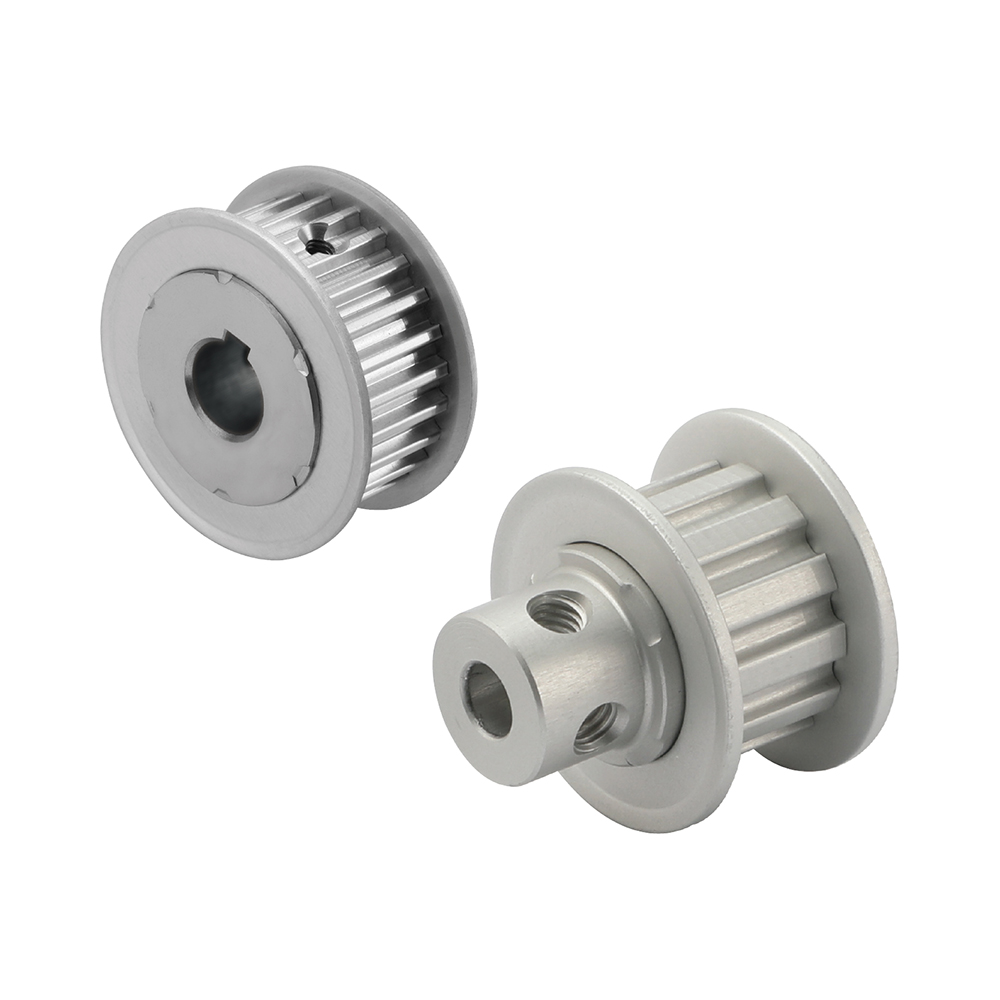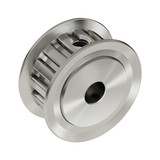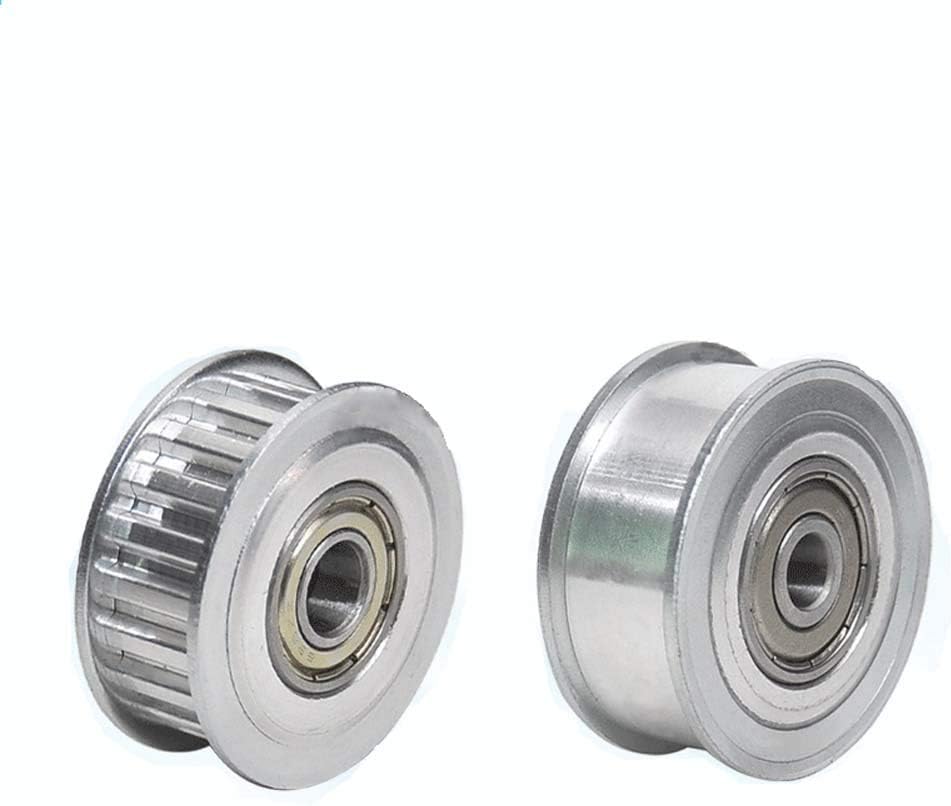Product Description
Product Description
1.Teeth Profile:
|
HTD: |
3M,5M,8M,14M,20M |
|||
|
T&AT: |
T2.5,T5,T10, AT5,AT10,AT20 |
|||
|
STPD: |
S2M,S3M,S4.5M,S5M,S8M,S14M |
|||
|
RPP: |
5M,8M,14M,20M |
|||
|
PGGT (PowerGrip GT): |
2MR,3MR,5MR,8MR,14MR |
|||
2. Materials:
Aluminum timing pulleys
Characteristics:
1.suitable for moderate power transmission
2.light weight / reduced rotational inertia
3.moderate chemical and corrosion resistance
4.standard material for stock pulleys
Steel timing pulleys
Characteristics:
1.suitable for high power transmission
2.durable
3.limited chemical and corrosion resistance
4.aesthetic material
3.Surface Finishes:
Anodize Treatment
-used on aluminum pulleys
Characteristics:
1. Increased chemical and corrosion resistance
2. Available in natural, black, or colored
3. Limited increase of surface hardness
4. Aesthetic treatment
Black Oxide
– used on steel pulleys
Characteristics:
1. Increased chemical and corrosion resistance
2. Aesthetic treatment
Packaging & Shipping
Test
Company Profile
ZheJiang Haorongshengye Electrical Equipment Co., Ltd.
1. Was founded in 2008
2. Our Principle:
“Credibility Supremacy, and Customer First”
3. Our Promise:
“High quality products, and Excellent Service”
4. Our Value:
“Being Honesty, Doing the Best, and Long-lasting Development”
5. Our Aim:
“Develop to be a leader in the power transmission parts industry in the world”
|
6.Our services: |
1).Competitive price |
|||
|
2).High quality products |
||||
|
3).OEM service or can customized according to your drawings |
||||
|
4).Reply your inquiry in 24 hours |
||||
|
5).Professional technical team 24 hours online service |
||||
|
6).Provide sample service |
||||
Main products
Machines
Exbihition
| Manufacturing Process: | Hobbing |
|---|---|
| Material: | Carbon Steel |
| Surface Treatment: | Polishing |
| Application: | Chemical Industry, Grain Transport, Mining Transport, Power Plant |
| Teeth Number: | 8-100t |
| Type for Arc Tooth: | 3m/5m/8m/14m/S3m/S5m/S8m |
| Samples: |
US$ 100/Piece
1 Piece(Min.Order) | |
|---|
| Customization: |
Available
| Customized Request |
|---|

What environmental factors should be considered when using XL pulleys outdoors?
When using XL pulleys outdoors, several environmental factors should be taken into consideration. Here is a detailed explanation of the factors that should be considered:
1. Moisture and Water Exposure:
Outdoor environments often expose XL pulleys to moisture and water, such as rain, humidity, or even direct water contact. It is crucial to consider the pulleys’ resistance to corrosion and rust in such conditions. Choosing pulleys made from materials with high corrosion resistance, such as stainless steel or coated alloys, can help prevent damage and ensure long-term performance.
2. Temperature Variations:
Outdoor environments may subject XL pulleys to temperature variations, including extreme heat or cold. Different materials exhibit varying thermal properties, so selecting pulleys with suitable temperature resistance is essential. Pulleys made from materials that can withstand the anticipated temperature range will help prevent deformation, cracking, or premature wear due to thermal expansion or contraction.
3. UV Radiation:
XL pulleys used outdoors are exposed to ultraviolet (UV) radiation from sunlight. Prolonged exposure to UV radiation can cause material degradation, discoloration, or loss of mechanical properties. Choosing pulleys with UV-resistant coatings or materials that are specifically formulated to withstand UV radiation can mitigate these effects and ensure the longevity and performance of the pulleys.
4. Dust and Particulate Matter:
Outdoor environments often contain dust, dirt, and other particulate matter that can accumulate on XL pulleys. The presence of debris can lead to increased friction, wear, and decreased performance. Choosing pulleys with smooth surfaces, effective seals, or protective covers can help minimize the ingress of dust and particulate matter, reducing the risk of damage and maintaining optimal operation.
5. Chemical Exposure:
In certain outdoor applications, XL pulleys may come into contact with chemicals, such as solvents, cleaning agents, or environmental pollutants. It is crucial to consider the chemical compatibility of the pulley materials with the substances present in the environment. Selecting pulleys made from chemically resistant materials or applying protective coatings can prevent chemical reactions, degradation, or premature failure.
6. Vibrations and Mechanical Stresses:
Outdoor environments may subject XL pulleys to vibrations and mechanical stresses caused by factors like wind, machinery vibrations, or uneven terrain. It is important to ensure that the pulleys are designed and installed to withstand these forces. Reinforcing the pulleys with appropriate structural features, such as additional ribs or thicker walls, can enhance their durability and prevent mechanical failures.
7. Maintenance and Inspection:
Outdoor XL pulleys may require more frequent maintenance and inspection compared to indoor applications. Regular cleaning, lubrication, and inspection of the pulleys can help identify and address any environmental damage or wear in a timely manner. Implementing a maintenance schedule and following manufacturer-recommended guidelines will ensure the pulleys remain in optimal condition.
By considering these environmental factors when using XL pulleys outdoors, it is possible to select pulleys that are specifically designed and constructed to withstand the challenges posed by the outdoor environment. This ensures reliable performance, longevity, and minimal downtime in outdoor applications.

Are there safety considerations when working with XL pulley systems?
Yes, there are several safety considerations that should be taken into account when working with XL pulley systems. Here are some important safety considerations:
1. Lockout/Tagout Procedures:
Before performing any maintenance or repair tasks on a power transmission system involving XL pulleys, it is crucial to follow proper lockout/tagout procedures. This involves isolating the system from its power source and ensuring that it cannot be energized accidentally. Lockout/tagout procedures help prevent unexpected startup of the system, which could cause serious injuries.
2. Personal Protective Equipment (PPE):
Wear appropriate personal protective equipment when working with XL pulley systems. Depending on the specific task and potential hazards, PPE may include safety glasses, gloves, hearing protection, and protective clothing. PPE helps protect against potential injuries from contact with moving parts, flying debris, or noise exposure.
3. Training and Competence:
Ensure that personnel working with XL pulley systems are adequately trained and competent to perform their tasks safely. They should be familiar with the proper procedures for installation, operation, and maintenance of the pulleys. Training should also cover the identification and understanding of potential hazards associated with the system and how to mitigate them.
4. Machine Guards:
Install appropriate machine guards and protective enclosures around the XL pulley systems to prevent accidental contact with moving parts. Guards help minimize the risk of entanglement, pinch points, or injuries caused by the rotating pulleys or the timing belt.
5. Risk Assessment:
Conduct a thorough risk assessment of the XL pulley system and its surrounding environment. Identify and evaluate potential hazards, such as pinch points, sharp edges, or electrical hazards. Implement control measures to mitigate the identified risks, such as implementing interlocks, providing warning signs, or establishing safe work procedures.
6. Regular Maintenance:
Perform regular maintenance and inspection of the XL pulley system to ensure its safe operation. This includes checking for any signs of wear, damage, or misalignment, as well as verifying the integrity of guards and safety devices. Address any maintenance issues promptly to prevent potential safety hazards.
It is important to consult relevant safety standards, guidelines, and regulations specific to your industry and jurisdiction when working with XL pulley systems. Adhering to these safety considerations will help protect personnel from injuries and create a safe working environment when interacting with XL pulley systems.

What materials are typically used in the construction of XL pulleys?
The construction of XL pulleys involves the use of various materials, depending on the specific application requirements, load capacity, and cost considerations. Here are the materials commonly used in the construction of XL pulleys:
1. Aluminum:
Aluminum is a lightweight and corrosion-resistant material commonly used in XL pulleys. It offers good strength-to-weight ratio and excellent machinability, making it suitable for many applications. Aluminum pulleys are often used in robotics, automation systems, and other applications where weight reduction is desirable.
2. Steel:
Steel is a durable and robust material used in XL pulleys for applications that require higher load capacity and strength. Steel pulleys provide excellent resistance to wear and can handle heavy-duty applications. They are commonly used in industrial machinery, automotive components, and other demanding applications.
3. Plastic:
Plastic pulleys are lightweight, cost-effective, and offer good resistance to chemicals and corrosion. They are commonly made from materials such as nylon, acetal, or polycarbonate. Plastic pulleys are used in a variety of applications, including 3D printers, medical devices, and smaller-scale machinery.
4. Composite Materials:
Composite materials, such as fiberglass-reinforced polymers, are sometimes used in the construction of XL pulleys. These materials offer a combination of properties, including high strength, low weight, and resistance to corrosion. Composite pulleys are often used in aerospace, marine, and other specialized applications.
5. Stainless Steel:
Stainless steel is chosen for XL pulleys when corrosion resistance is of utmost importance. Stainless steel pulleys exhibit excellent resistance to rust and corrosion, making them suitable for applications in harsh environments or where exposure to moisture or chemicals is expected.
It’s important to note that the material selection for XL pulleys depends on factors such as the application requirements, load capacity, environmental conditions, and budget constraints. Manufacturers consider these factors to determine the most suitable material for achieving the desired performance and reliability in specific applications.


editor by CX
2023-10-20
